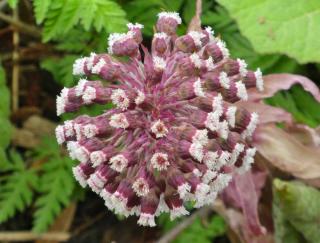

A dioecious herbaceous perennial plant that belongs to the Asteraceae family, butterbur can be identified thanks to its scale-like floral scapes bearing flowers
without any peduncles, tightly grouped together. It bears giant leaves at its center. Just like coltsfoot, butterbur grows on the sides of swamp lands and waterlogged banks of creeks. It can also be found in forest underbrush and ditches, to an altitude of about 5,000 feet (1,500 m).
Native to North Africa, Asia, the Middle East and Europe, butterbur, also called “ringworm herb”, is a plant for which the medicinal properties have been noted for centuries.
Which are these? How effective are these properties to benefit the human body? To what extent? Which precautions must be taken?
Here is what you need to know…
 The scientific name of butterbur is “petasites”, which comes from ancient Greek “petasos”. This designates a wide-brimmed felt hat that Greek shepherds used to wear.
The scientific name of butterbur is “petasites”, which comes from ancient Greek “petasos”. This designates a wide-brimmed felt hat that Greek shepherds used to wear.
Indeed, this name refers to the size of this plant’s leaves, which were also used to wrap slabs of butter to protect them from ambient heat.
Most production-targeted butterbur is harvested in the wild in Eastern Europe.
Due to its therapeutic properties, this plant is sold in the form of food supplements. The portions of the plant used for this are the leaves and rhizome.
But what are the health benefits and properties of this plant? What does it cure? How should one use it wisely?
For centuries, European peoples have been availing butterbur’s therapeutic benefits.
In the Middle Ages, it was used to treat fever and counter the plague.
In the 17th century, this medicinal herb served as dressing for wounds, was used to treat asthma, cough and respiratory disorders (whether related to allergies or not).

Known butterbur extracts would alleviate hay fever, prevent gastric ulcers, quell gastro-intestinal spasms and stave off bouts of migraine.
Moreover, the medicinal properties of ringworm herb were proven to be effective when dealing with pain related to spasms of the urinary tract, more specifically kidney stones.
A true anti-allergy, butterbur is prescribed today to soothe:
– symptoms of seasonal allergy (sneezing, itchiness around the eyes, nasal discharges) without inducing drowsiness nor any side-effects usually associated to ingesting antihistamine treatments.
– joint pain
– irritations of the small intestine
To treat seasonal allergy, the usual dosage that’s recommended for an adult is 50 to 75 mg of extract ingested 2 times a day.
As for children aged 10 to 12 years old, the adequate dose is 25 mg, 2 times a day.
Butterbur must not be ingested raw! This is because it naturally contains pyrrolizidine alkaloids that are poisonous and carcinogenic for the lungs and liver.
Consequently, refrain from any product that isn’t labeled “PA free”.
– to pregnant women and nursing mothers
– to persons allergic to plants of the Asteraceae family
– to persons suffering of liver deficiency or who have previously experienced hepatitis.
In any case, it is strongly recommended to ask your consulting physician‘s or pharmacist’s opinion for adequate prescribing.